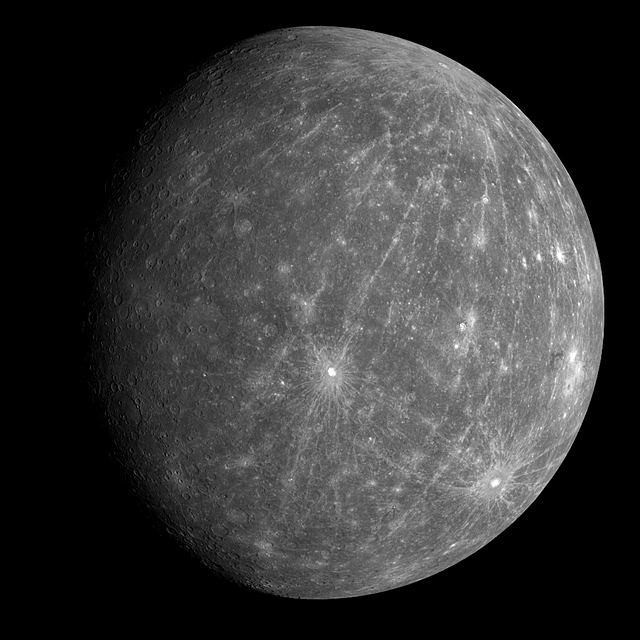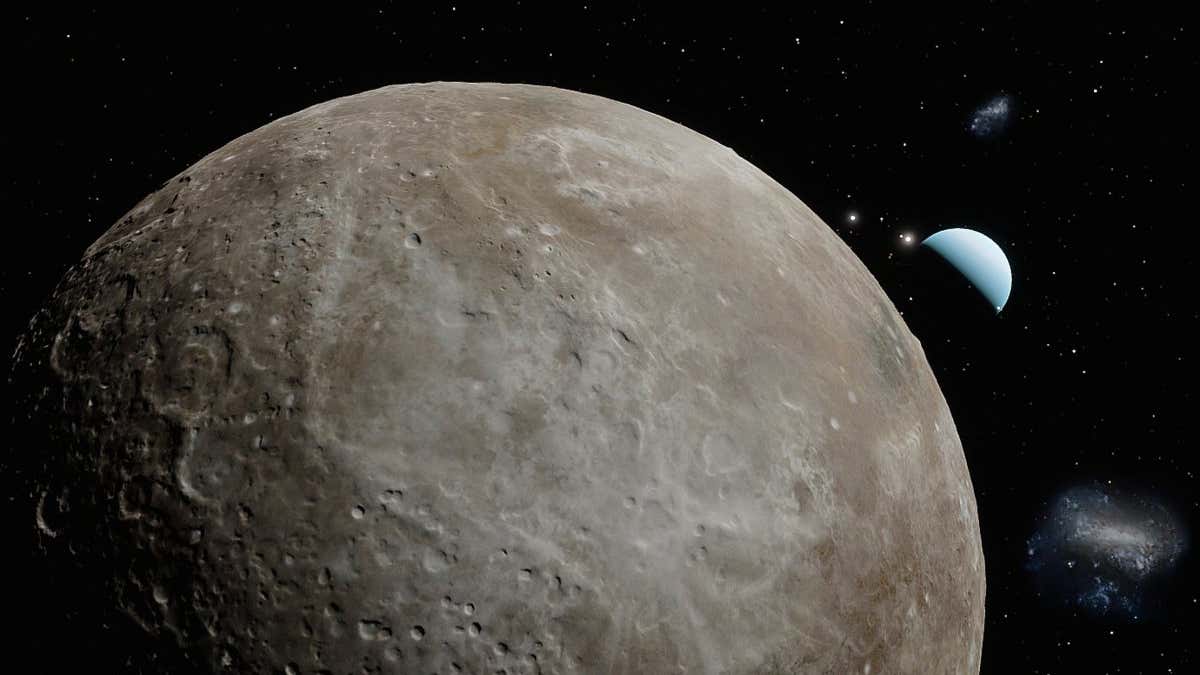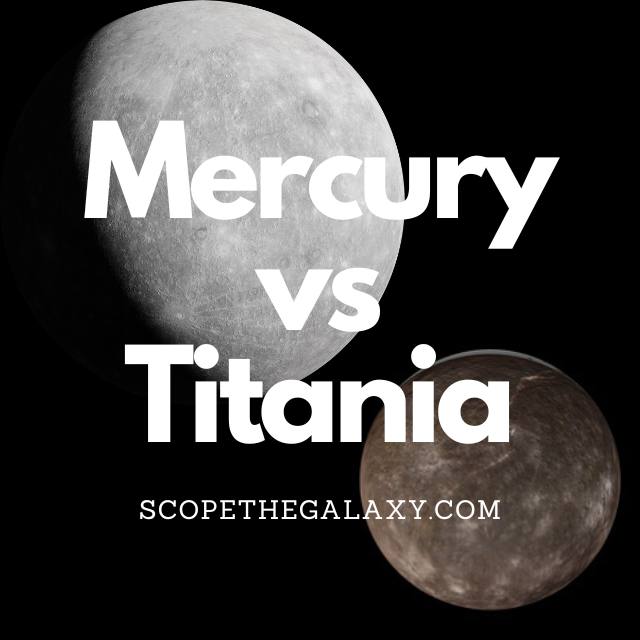*This post may contain affiliate links. This means we may make a commission if you purchase an item using one of our links*
The main differences between Mercury and Titania are that Mercury is a the closest planet to the Sun whilst Titania is a natural satellite that orbits Uranus, Titania is smaller with a diameter of 1576.8km whilst Mercury has a diameter of 4,879km and Mercury is in a 3:2 orbital resonance whereas Titania is tidally locked to Uranus.
For a more detailed look at each body continue reading as it will discussed in more detail in the sections below.
What Is The Planet Mercury?
Table of Contents

Mercury is the planet closest to our Sun and would fall under the terrestrial planet moniker. Out of the 8 main line planets Mercury is also the smallest, coming in at 4,879km.
This planet is known for having its fair share of craters, which is mostly down to its thinner non protective atmosphere that is unable to stop interstellar debris from striking its surface.
Despite its close proximity to the Sun, Mercury is not the hottest planet in our solar system but, it does come in second, just behind Venus. It’s surface temperature is around 430 degrees on the upper end with the average temperature around 167 degrees Celsius whereas its core is far hotter at around 1,600 – 3,000 degrees Celsius.
Due to it close proximity to our local star, Mercury is unable to sustain a moon around its orbit and even has a very unique rotation around the Sun where it has 3:2 orbital resonance with the Sun.
As for how long it takes for the planet to rotate around our yellow dwarf star, its the shortest time period of 88 days for obvious reasons, whilst a single day on the planet takes 58.65 Earth days to complete. Its axial tilt is only 2 degrees to the right, making it amongst the straightest planets in the solar system too.
What Is The Moon Titania?

Titania is the biggest of Uranus’s moons, with a circumference of 4,956km and a diameter of 1576.8km.
The high density of this moon suggests that it most likely formed from a collection of dust and debris leftover from the formation of Uranus or from the debris created in the collision that reportedly tilted Uranus onto its side. As a result Titania has a mass of 3.4 × 10^21 kg.
First discovered on 11th January 1787 (the same day as the discovery of Oberon, the second biggest moon of Uranus) by British astronomer William Herschel, the name “Titania” comes from the Shakespeare play, A Midsummer Night’s Dream. (Most of Uranus’ moons are named after Shakespeare’s characters.)
Having observed Titania for many years, scientists theorize that its composition is likely to be equal parts ice and rock, the latter of which may contain carbonaceous materials and organic compounds.
Research suggests that the moon most likely has a rocky core (accounting for 66% of the moon’s radius) and an icy mantle. If the mantle contains ammonia, it will act as antifreeze and make it possible for liquid water to exist. In this instance, the moon could possess a layer of liquid ocean around 50km thick.
Titania tilts slightly towards the equator of Uranus and is tidally locked to its planet. This means a Titania day is 8 days and 17 hours which would be the same for its orbital cycle. Titania has an average temperature of -203 degrees Celsius.
The planet Uranus is also tilted, with the moons orbiting on the equatorial plane, giving it extreme seasons. On Titania, the north and south poles experience 42 years of complete sunshine followed by 42 years of total darkness.
Scientists have observed the presence of large amounts of carbon dioxide, suggesting this may be the primary component of this moon’s atmosphere. Thanks to the tilted orbit, and a concentration of solar radiation from the poles, Titania probably maintains a carbon dioxide cycle, similar to the hydrogen cycle on Earth.
Similarities Between Mercury And Titania
Titania and Mercury do have their fair share of similarities, which in this case would include the following:
- Both have a hotter central core.
- Both are a spherical in shape.
- Both are terrestrial planets.
- Both have a very thin atmosphere and a rocky surface.
- Both have no other natural satellites orbiting them.
- Neither have tectonic plates.
Differences Between Mercury And Titania
As for the differences between the two, they include the below.
- Titania orbits Uranus whilst Mercury only orbits the Sun.
- Mercury is a terrestrial planet whilst Titania is a terrestrial based natural satellite.
- Mercury has a diameter of 4,879km whilst Titania’s diameter is 1,576.8km.
- Titania has a very thin exosphere composed mostly of carbon dioxide whilst Mercury has very thin atmosphere composed of oxygen, sodium and hydrogen.
- A day on Titania takes 8 days 17 hours whilst a Mercury day takes 58.65 days.
- It takes Titania 8 days 17 hours to orbit Uranus and around the Sun in 84 years whilst Mercury orbits the Sun in 88 days.
- Mercury has an axial tilt of 2 degrees whilst Titania’s axial tilt is closer to 0.
- Titania’s average temperature is around -203 degrees Celsius whilst Mercury has an average temperature of 167 degrees Celsius.
- Mercury’s density is 5.43 g/cm³ whilst Titania’s density is 1.71 g/cm³.
- Mercury’s mass is 3.285 × 10^23 kg whilst Titania’s mass is 3.4 × 10^21 kg.
- Titania’s gravitational strength is 0.367 m/s² whilst Mercury’s is 3.7 m/s².
- Titania is tidally locked to Uranus whilst Mercury is is not tidally locked to any entity but is in a 3:2 orbital resonance with the Sun.
- Mercury has a magnetosphere whilst Titania does not.
- Titania may have water within its surface whilst Mercury does not.
Summary
Mercury and Titania do have their odd few similarities such as their rocky natures, the lack of moons that orbit them and even their generally thinner atmosphere, however they have their fair share of differences too.
Whether it be in regards to size, mass, gravitational strength, density and more, these two are designed to function very differently within our solar system as a whole.

